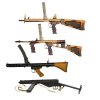cluttonfred
Member
So, while lots of folks in the Concept design for a modern Sten thread had mixed feelings about the basic premise, the consensus of those who responded on the design questions was that the basic Sten design is still the best way to go for a low-tech, low-cost machine-shop approach.
I should add that I am a big fan of the Australian Owen gun, which while it was expensive to make with a lot of machining did have some great features and was much liked by those who carried it. I especially like the Owen gun's attention to fighting jams from sand and dirt by using a separate cocking handle to eliminate the cocking handle slot near the bolt, and the top-feed magazine which means any dirt that does get it tends to fall out the ejection port. I admit that the magazine placement is awkward, but it does allow downward ejection, and that suggests a bullpup, hmmm....
So how about a Sten Mark III-type design with some Owen influence: a basic Sten-style tubular receiver, open bolt, blowback action with advanced primer ignition; M3 Grease-gun style dual guide rods and recoil springs; Owen-style top-loading magazine and downward ejection; forward mounted cocking handle with pushrod to bolt and pistol-grip/trigger assembly. A straight-line set-up makes it easier to control on full-auto, though it does require high-mounted sights, and we need a real safety since the cocking handle is no longer on the bolt.
With apologies to the late Evelyn Owen, here are a couple of illustrations. The Islander images, you can see, were made by playing with a photo of an Owen gun and yes, some of the images are mirrored so ignore the cocking handles on the wrong side, etc.
First illustration: Islander traditional layout, Owen Mark 1-43, F1 (an "Owenized" Sterling for the Aussies) and Sten Mark III.
Second illustration: Islander traditional layout vs. bullpup. Both have the same barrel length, the bullpup obvious gives up a lot of sight radius in exchange for a much shorter length, and I reversed the magazine catch so you don't bump it with your nose.
OK, flame away!
I should add that I am a big fan of the Australian Owen gun, which while it was expensive to make with a lot of machining did have some great features and was much liked by those who carried it. I especially like the Owen gun's attention to fighting jams from sand and dirt by using a separate cocking handle to eliminate the cocking handle slot near the bolt, and the top-feed magazine which means any dirt that does get it tends to fall out the ejection port. I admit that the magazine placement is awkward, but it does allow downward ejection, and that suggests a bullpup, hmmm....
So how about a Sten Mark III-type design with some Owen influence: a basic Sten-style tubular receiver, open bolt, blowback action with advanced primer ignition; M3 Grease-gun style dual guide rods and recoil springs; Owen-style top-loading magazine and downward ejection; forward mounted cocking handle with pushrod to bolt and pistol-grip/trigger assembly. A straight-line set-up makes it easier to control on full-auto, though it does require high-mounted sights, and we need a real safety since the cocking handle is no longer on the bolt.
With apologies to the late Evelyn Owen, here are a couple of illustrations. The Islander images, you can see, were made by playing with a photo of an Owen gun and yes, some of the images are mirrored so ignore the cocking handles on the wrong side, etc.
First illustration: Islander traditional layout, Owen Mark 1-43, F1 (an "Owenized" Sterling for the Aussies) and Sten Mark III.
Second illustration: Islander traditional layout vs. bullpup. Both have the same barrel length, the bullpup obvious gives up a lot of sight radius in exchange for a much shorter length, and I reversed the magazine catch so you don't bump it with your nose.
OK, flame away!



